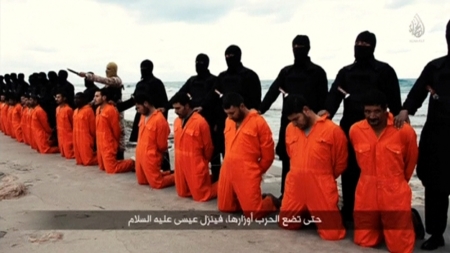Pope Francis adds 21 Coptic martyrs killed by ISIS to Catholic calendar

In an extraordinary move bridging a historical rift dating back to 451AD, Pope Francis has added the 21 Coptic Christians martyred by Islamic State terrorists on a Libyan beach in 2015 to the Roman Catholic Church’s calendar, declaring them saints.
The pontiff announced the decision during a recent meeting in Rome with Pope Tawadros II of Alexandria, the Coptic Patriarch, marking a significant step in resolving doctrinal disputes between the Roman Catholic and Coptic Churches, which have viewed each other as fundamentally heretical for over a millennium, The Telegraph reported.
The meeting, which celebrated the 50th anniversary of Pope Paul VI’s meeting with Pope Shenouda III of Alexandria, signified a commitment to overcoming the deep-rooted theological differences that emerged in the fifth century. The 451 AD schism was based on differing views of the nature of Christ, which resulted in the Catholic Church and the Coptic Orthodox Church going separate ways.
The Coptic Orthodox Church had already venerated the martyrs, 20 of whom were Egyptian workers and one Ghanaian, Matthew Ayariga. They were killed in a gruesome spectacle orchestrated by ISIS.
Dressed in orange jumpsuits and forced to kneel in the sand, the men were beheaded, their executioners shrouded in black and filmed against a backdrop of the sea. Images of the martyrs have since been used to create religious icons.
ISIS labeled those killed as “People of the Cross,” alleging they were idolaters, not worshipers of God. Ayariga, in his final moments, affirmed: “I am a Christian. I am like them.” His precise church affiliation remains unknown.
A week after the brutal killings, Pope Tawadros II declared all 21 martyrs as saints.
In 2018, their burial place was discovered, allowing the bodies of the 20 Egyptian victims to be returned to their homeland, followed by Ayariga’s in 2020.
Francis spoke of the martyrs’ baptism of blood, a belief tracing back to the early years of the Church that admittance to Heaven can be granted through martyrdom, even without symbolic, traditional water baptism.
According to an op-ed piece by Christopher Howse in The Telegraph, historically, the Copts, representing more than 10% of Egypt’s 110 million population, were seen as Monophysites in the West, believing that the divinity of Jesus was paramount, somewhat undermining His humanity. And, for their part, Copts perceived Western Christians as heretics, likening them to Nestorian Assyrians. "In practice I suspect good Copts and good Assyrians believed the real Christian teaching about Jesus as God and man," Howse adds.
During last week’s meeting, Pope Tawadros II presented Pope Francis with a relic of the martyrs as a symbol of gratitude, a gesture that was warmly received.
Pope Francis said of the martyrs, “These martyrs were baptized not only in the water and Spirit, but also in blood, a blood that is the seed of unity for all of Christ’s followers,” according to the U.S. Conference of Catholic Bishops.
The pope’s recognition of the 21 men as martyrs killed not because of their specific denomination but because they were Christians, relates to a statement he made in 2013 when he said, “In some countries they kill Christians for wearing a cross or having a Bible and before they kill them they do not ask them whether they are Anglican, Lutheran, Catholic or Orthodox.”
This move toward unity and mutual recognition comes as religious persecution worldwide intensifies, with Francis noting that more Christians have been martyred for their beliefs in the past century than in all of the early centuries combined.
The addition of the Coptic martyrs to the Catholic calendar signifies an unpreceded step in the ecumenical efforts of the Catholic Church. Bishop Brian Farrell, secretary of the Dicastery for Promoting Christian Unity, described this as “a first” in the history of the Roman Catholic Church.





















